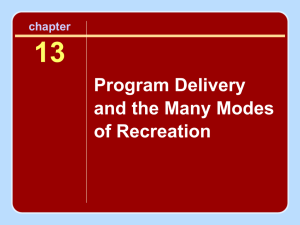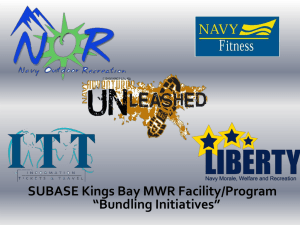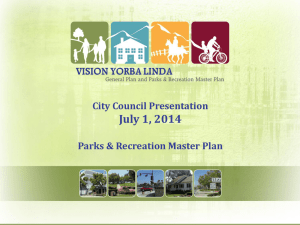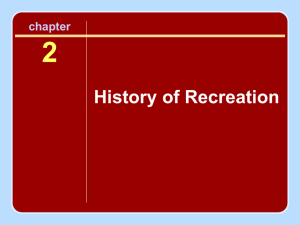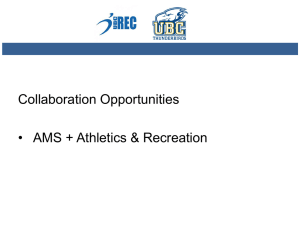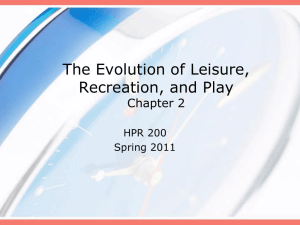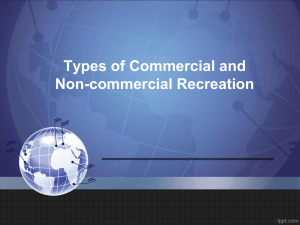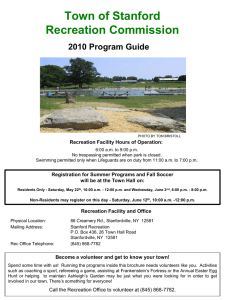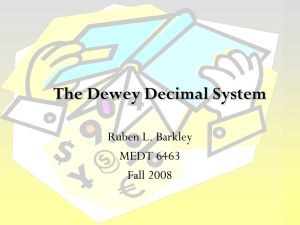Chapter2 - Sagamore Publishing
advertisement
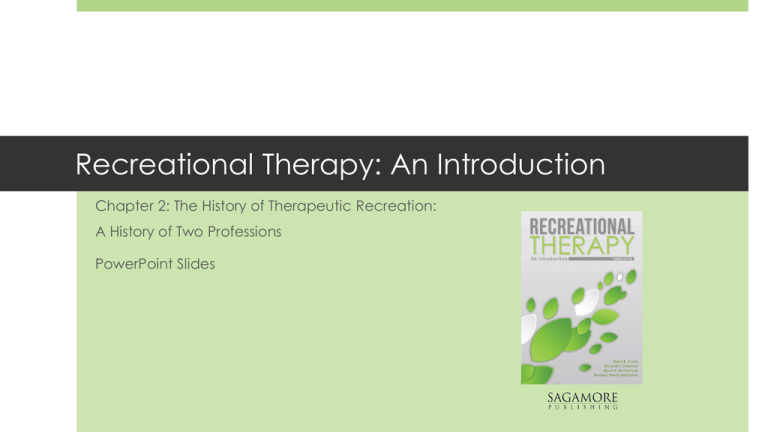
Recreational Therapy: An Introduction Chapter 2: The History of Therapeutic Recreation: A History of Two Professions PowerPoint Slides “The Great Acceleration” With WWII came the beginnings of “The Great Acceleration,” or vast growth in recreational therapy. More than 1,800 Red Cross Recreation Workers were employed to serve hospitalized soldiers during WWII. The VA began recreation programs in its hospitals, which developed into recreational therapy services. Following WWII, RT services were initiated in state psychiatric hospitals and in state institutions for residents with intellectual disabilities (termed mental retardation at the time). With the growth in RT came efforts toward professionalization. Hospital Recreation Section of the ARS Formed in 1948 as a branch of the American Recreation Society. Saw recreation as an end in itself. Believed in the credo of “recreation for all.” National Association of Recreational Therapists (NART) An independent association that began in 1952. Primarily composed of recreational therapists from state psychiatric hospitals and state schools for persons with intellectual disabilities. Believed in the use of recreation as therapy or recreation as a treatment tool. National Therapeutic Recreation Society (NTRS) Those in the Hospital Recreation Section of ARS and the National Association of Recreational Therapists (NART) came together to form NTRS in 1966. NTRS was a branch of the National Recreation and Park Association. Under NTRS professionalization did occur: A scholarly journal, the Therapeutic Recreation Journal was established in 1966. Guidelines for practice were published. A growing number of universities established TR programs. An expansion in the publication of textbooks and other professional literature occurred. A credentialing program was established under the National Council on Therapeutic Recreation Certification (NCTRC). Even with professionalization, the lack of a single professional philosophy hampered the development of TR Because the field of therapeutic recreation had not established a single philosophical position to form a basis for its practice, it languished. Hemingway (1986) stated that therapeutic recreation had been absorbed with developing the “trappings of a profession” to the neglect of establishing a philosophical foundation for practice. Even with the formation of NTRS conflicts raged between: The HRS/ARS position of recreation as an end. The NART position of recreation as therapy or recreation as a means. Continuing conflict between the “means vs. ends” views… Professor Carol Peterson, coauthor of the Leisure Ability Model, stated that “from the beginning, it appears there has been debate over the basic issue of whether therapeutic recreation (or recreational therapy) is or should be therapy oriented or leisure oriented.” A new professional organization begins… Ultimately philosophical conflicts between the leisure orientation and the therapy orientation and a desire for an autonomous professional organization lead to the formation of the American Therapeutic Recreation Association (ATRA). ATRA was formed in 1984. Philosophical foundations lacking for therapeutic recreation Authors, such as Lahey, Mobley, and Sylvester, made a strong case that every profession needs an agreed-upon philosophy that offers a clear position from which it may interpret what it does and on which it may base practice. Yet these authors lamented, that in reviewing the history of therapeutic recreation, such a clear philosophical position has been lacking. Other authors commented on the history of TR… Shank and Kinney (1987) stated the history of therapeutic recreation has “one consistent theme: the uneasy fit between recreation as a contributor to the normalization and life quality of persons with disability and recreation as a means to improve an individual’s psychological and physical functioning.” Other authors commented on the history of TR… Sylvester (2009) suggested therapeutic recreation has been “caught between two traditions that have resisted assimilation into a single practice” and concluded that these two orientations are “fundamentally different practices.” Other authors commented on the history of TR… Austin and Crawford (2015): “The history of therapeutic recreation clearly shows two practices have existed, each with a distinctive philosophy. One philosophy grew out of the traditions of the Hospital Recreation Section of the American Recreation Society, could be termed the leisure orientation philosophy or leisure facilitation philosophy. This philosophical position perceives leisure as an end, not a means.” (quote continued next slide) Austin and Crawford quote continued… “The second philosophy, which professionals in the National Association of Recreational Therapists embraced, takes the approach of recreation as therapy that sees recreation as a means, not an end. This position could be termed the recreational therapy philosophy.” Austin (2014) has concluded that: “Both philosophical positions are strong enough to support two worthy professions, each of which should find their rightful places among kindred professions. Those who hold the “leisure for all” philosophy certainly can have an important place within the leisure service professions. Those who embrace the “therapy” philosophy position can assume their natural positon within the healthcare professions.” Do you agree with the authors of our text that: “Professionals within the field of therapeutic recreation should consider that the field is made up of two distinct professions. Furthermore, the expression recreational therapy should be used to interpret the use of recreation as a means to health.”

